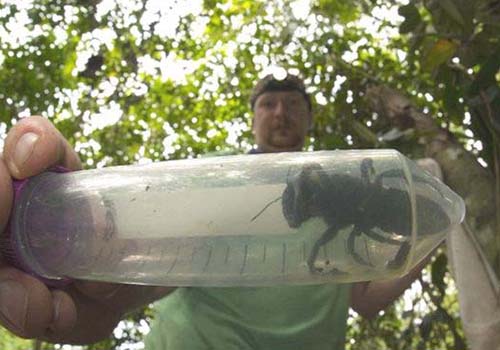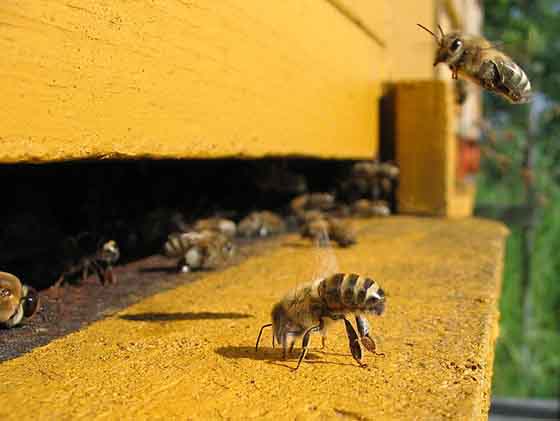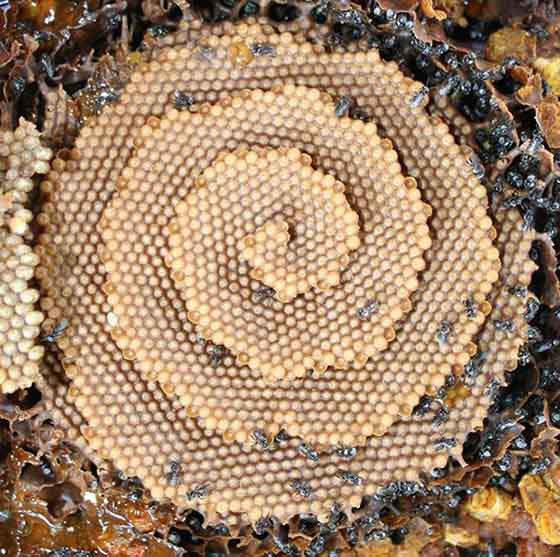

Bees are flying insects closely related to wasps and ants, known for their role in pollination and, in the case of the best-known bee species, the western honey bee, for producing honey and beeswax. Bees are a monophyletic lineage within the superfamily Apoidea and are presently considered a clade, called Anthophila. There are over 16,000 known species of bees in seven recognized biological families. They are found on every continent except Antarctica, in every habitat on the planet that contains insect-pollinated flowering plants. Read more ...
World's biggest bee found alive BBC - February 21, 2019

The world's biggest bee has been re-discovered, after decades thought lost to science. The giant bee - which is as long as an adult's thumb - was found on a little-explored Indonesian island. After days of searching, wildlife experts found a single live female, which they photographed and filmed. Known as Wallace's giant bee, the insect is named after the British naturalist and explorer Alfred Russel Wallace, who described it in 1858. Scientists found several specimens in 1981 on three Indonesia islands. It has not been seen alive since, although there was a report last year of two bee specimens being offered for sale online. In January, a team followed in Wallace's footsteps on a journey through Indonesia in an attempt to find and photograph the bee

Colony collapse disorder (CCD) is the phenomenon that occurs when the majority of worker bees in a colony disappear and leave behind a queen, plenty of food and a few nurse bees to care for the remaining immature bees and the queen. While such disappearances have occurred throughout the history of apiculture, and were known by various names (disappearing disease, spring dwindle, May disease, autumn collapse, and fall dwindle disease), the syndrome was renamed colony collapse disorder in late 2006.
in conjunction with a drastic rise in the number of disappearances of western honey bee (Apis mellifera) colonies in North America. European beekeepers observed similar phenomena in Belgium, France, the Netherlands, Greece, Portugal, and Spain, Switzerland and Germany, albeit to a lesser degree, and the Northern Ireland Assembly received reports of a decline greater than 50%.
Colony collapse disorder causes significant economic losses because many agricultural crops (although no staple foods) worldwide are pollinated by western honey bees. According to the Agriculture and Consumer Protection Department of the Food and Agriculture Organization of the United Nations, the worth of global crops with honey bee pollination was estimated at close to $200 billion in 2005. Shortages of bees in the US have increased the cost to farmers renting them for pollination services by up to 20%.
In the six years leading up to 2013, more than 10 million beehives were lost, often to CCD, nearly twice the normal rate of loss. To put this in perspective, according to U.N. FAO data, the world's beehive stock rose from around 50 million in 1961 to around 83 million in 2014, which is about 1.3% average annual growth. Average annual growth has accelerated to 1.9% since 2009.
Several possible causes for CCD have been proposed, but no single proposal has gained widespread acceptance among the scientific community. Suggested causes include: infections with Varroa and Acarapis mites; malnutrition; various pathogens; genetic factors; immunodeficiencies; loss of habitat; changing beekeeping practices; or a combination of factors. A large amount of speculation has surrounded a family of pesticides called neonicotinoids as having caused CCD. Read more ...

Did the bees leave us a message about creation - Logarithmic Spiral?
Is the message also about collapsing grids?
Here's the Buzzzzzz
Nobody Knows Why These Bees Built a Spiral Nest Live Science - January 23, 2018
The Australian stingless bee Tetragonula carbonaria is not your average pollinator. For starters, out of about 20,000 known bee species in the world, T. carbonaria is one of only 500 without stingers. That's not to say this bee is defenseless. Invasive beetles that have tried to infiltrate T. carbonaria nests have found themselves suddenly covered in a brew of wax, mud and plant resin - effectively mummified alive by bees. T. carbonaria colonies have also been observed waging days-long territory wars against their stingless neighbors, resulting in hundreds of bee-on-bee casualties and queens unceremoniously dethroned. This is all to say, if you had a home like T. carbonaria's, you'd probably fight for it, too. As seen in a popular photo posted to Reddit last week, swarms of T. carbonaria rear their young in mesmerizing, spiral-shaped towers called brood combs, linking hundreds of individual egg chambers together into a continuous staircase of unborn baby bees.